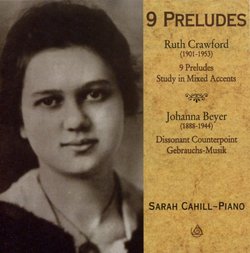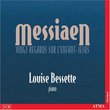Significant, but stern
Discophage | France | 04/06/2007
(4 out of 5 stars)
"Before the revival of interest for the music of Ruth Crawford that took place in the 1990s, her Piano Preludes (composed between 1924 and 1928) were one of her regularly performed and recorded compositions. Stylistically the musical language is somewhere around Berg's Piano Sonata - but without the Viennese's lush post-romantic sweep and seductiveness - or the early "expressionist" piano compositions of Eisler, Krenek and Hauer. The deep-sounding rumblings of # 9 "tranquillo" are evocative of Cowell's clusters. The moods are not very varied, and except in the (slightly) more playful # 2 "Allegro giocoso" and # 8 "Leggiero" they are mostly somber, stern, brooding. The 1931 Piano Study in Mixed Accents is a brief (1:05) and virtuosic tour de force, an angry ascension from low to high register and back.
I first discovered the music of Johanna Beyer through her impressive 1937 Suite for Violin and Piano played by Miwako Abe and Michael Kieran Harvey on a New World Records collection with works by Cowell, Antheil, Ruth Crawford and others (see my review of Works for Violin by George Antheil; Johanna Beyer; Henry Cowell; Ruth P. Crawford; Charles Dodge; David Mahler, Larry Polansky, Stefan Wolpe), and it made me want to explore more of this composer. Very little is known of her, there are not even any known photographs. She was born in Leipzig in 1888, moved to New York in 1924 where she participated in the circle of modernist musicians around Henry Cowell, Charles Seeger, Ruth Crawford and Carl Ruggles. She died a premature death in 1944 of Amyotrophic lateral sclerosis , a neurodegenerative disease, and she fell into oblivion, until the late 80s and 90s, when a rediscovery of sorts took place. Her main output dates from the 1930s, as with "Dissonant Counterpoint" and "Gebrauchs-musik". Dissonant counterpoint is the theory formulated by Charles Seeger, consisting of a reversal of the rules of traditional counterpoint, establishing "dissonance, rather than consonance, as the rule". Well - what you see is what you get, in the same-titled piece as well as in "Gebrauchs-musik", which apparently pays tribute to Hindemith's "utility music" in title only, but not in compositional style. Beyer's dissonant counterpoint is terse, enigmatic, quasi-Webernian in its sparse, pointillistic textures (the piano part of Schoenberg's Pierrot Lunaire also comes to mind), stylistically pretty close to Crawford's preludes. The liner notes are quite honest about it: "they are difficult, both to play and to understand, and the casual listener may not at first hear the rich musical detail embedded in the straightforward, two-part invention piano style".
This recording, made in 1999 and released in 2001, was the first commercial recording of music of Johanna Beyer. It contains thorough and informative notes by composer and musicologist Larry Polansky, who is the driving force behind the rediscovery of Johanna Beyer. Sarah Cahill, also highly instrumental in the rediscovery of this music, seems to acquit herself expertly, with a lighter touch (and much better recording) than the mystically heavy-handed Schleihermacher in Crawford's Preludes (American Ultramodernists 1920-1950), more frenzy but less snappy articulation than Reinbert de Leeuw (on DG's survey of the composer, Ruth Crawford Seeger: Portrait) or Alan Feinberg (with a more opaque recording, in The American Innovator) in the Piano Study in Mixed Accents.
This is not easy and seductive listening, but it is a significant recording, enabling us to hear two important female composers and early American modernists.
"


 Track Listings (23) - Disc #1
Track Listings (23) - Disc #1